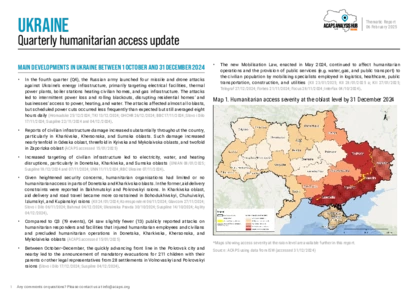Latest updates on country situation
15 April 2025
By 9 April 2025, civilian infrastructure damage in Kryvorizkyi raion (Dnipropetrovska oblast) was 40% higher within the year at 98 counts compared to the entire 2024 (70). Most of the damage is to industrial or business facilities, likely affecting the local economy. This increase comes as Russian forces have increased ground conflict intensity in western parts of Zaporizka oblast. (ACAPS accessed 14/04/2025, ISW 09/04/2025, ACLED accessed 08/04/2025)
02 April 2025
On 25 March 2025, the US reached an agreement with Ukraine and Russia on a temporary pause in attacks on energy infrastructure, although the details remain unclear. Despite the agreement, Russian forces have continued attacking Ukrainian energy infrastructure, causing localised electricity disruptions. One such attack on 27 March on Kharkiv temporarily left people without heating, while on 1 April, an attack on Kherson city left 45,000 civilians without electricity. (LB 31/03/2025, ISW 01/04/2025, Slovo i Dilo 02/04/2025)
31 March 2025
During the first two months of 2025, intensified hostilities along the frontline led to the displacement of over 20,000 people to safer areas away from the frontline. Out of the 20,000 IDPs, 9,800 were from Donetska oblast and 4,450 from Khersonska. ([OCHA 27/03/2025(https://reliefweb.int/report/ukraine/ukraine-humanitarian-situation-snapshot-january-february-2025-enuk))
25 March 2025
On 24 March 2025, a Russian missile and drone attack on Sumy city injured 106 people, including 23 children, in Sumska oblast. Overall, 73 buildings were damaged, including three schools, a kindergarten, a hospital, and 61 residential units. State responders provided immediate emergency, rescue, and psychological support, followed by the restoration of water and gas supply. The people affected require legal, cash, and shelter assistance. Since late February, heightened hostilities in Kursk oblast in Russia has led to a rise in attacks on the communities along the border with Sumska oblast, resulting in casualties; damage to private homes, transportation, and critical infrastructure; and disruptions to water and power supplies. On 13 March, the authorities of Sumska oblast announced a mandatory evacuation of 543 civilians, including children, from eight communities in the Yunakivska and Myropilska hromadas of Sumskyi raion, which are located within 0–10km of the Russian border. (Sumy City Council 25/03/2025, Ukrinform 13/03/2025, ACLED accessed 25/03/2025)
24 October 2024
The Russian Federation continues to attack the ports in Odeska oblast after withdrawing from the Black Sea Grain Initiative on 17 July 2023. A spike in attacks occurred between August–September, following a yearly trend of Russia targeting and damaging grain storage facilities after the harvest season, port infrastructure and vehicles, and foreign vessels. Until 11 October 2024, Russia conducted more than 60 ballistic missile and drone attacks during a three-month period. These attacks resulted in civilian casualties, mainly port and ship employees. Complicated logistics through river ports and railways increase costs, an additional strain on Ukraine’s already weakened economy. (ISW 14/10/2024, Radio Svoboda 11/10/2024, APK-Inform 11/10/2024)
17 September 2024
On 20 August 2024, the authorities announced a mandatory evacuation in Pokrovska hromada, Donetska oblast, as a response to increased hostilities and a shifting front line. Until 12 September, 28,000 people remained living there with no access to essential services. There was no gas supply, and the water pumping station had stopped functioning. The last civilian hospital in Pokrovsk town evacuated on 7 September. (OCHA 12/09/2024, MSF 06/09/2024)
08 July 2024
On 8 July 2024, Russian forces launched a combined missile attack on several Ukrainian cities, killing at least 43 and injuring over 170. 70% of the casualties were in Kyiv city. The attacks also damaged several civilian facilities, including kindergartens, a college, and two hospitals in Dnipro, Kramatorsk, Kryvyi Rih, Kyiv, and Sloviansk cities. The damage to the children’s hospital in Kyiv city has affected critical healthcare access as it was the largest in the country, conducting 7,000 surgeries yearly and providing cancer and haematological treatment. More than 600 patients have had to evacuate, with over 100 transferred to other facilities. Over 90% of civilian casualties and more than 95% of damage to educational and health facilities continue to take place in areas under the control of the Ukrainian Government. (The Kyiv Independent 09/07/2024, CNN 08/07/2024, OHCHR 07/06/2024)
current crises
in
Ukraine
These crises have been identified through the INFORM Severity Index, a tool for measuring and comparing the severity of humanitarian crises globally.
UKR002 - Russia-Ukraine conflict
Last updated 28/03/2025
Drivers
Conflict
Displacement
Crisis level
Country
Severity level
4.4 Very High
Access constraints
5.0
Analysis products
on
Ukraine
31 March 2025
Ukraine: scenarios in 2025
DOCUMENT / PDF / 1 MB
This report considers three distinct yet plausible futures for Ukraine through the end of 2025. They focus on how changes in the situation in the country will affect people’s ability to meet their basic needs and affect humanitarian operations in and around Ukraine.
31 March 2025
Ukraine: implications of the US foreign aid cuts
DOCUMENT / PDF / 766 KB
This report provides an overview of the implications of the US foreign aid freeze and cuts on humanitarian, development, and government programmes, with a focus on the impacts on humanitarian response capacity and affected communities. It aims to support donor contingency planning and the advocacy efforts of affected organisations.
Attached resources
20 March 2025
Ukraine: humanitarian implications of the war in Ukrainian-controlled territory in Khersonska oblast
DOCUMENT / PDF / 2 MB
The report aims to present the war-related developments and resulting humanitarian impacts in the Ukrainian-controlled territory of Khersonska oblast (namely Beryslavskyi raion and six hromadas of Khersonskyi raion since July 2024.
Attached resources
19 February 2025
Ukraine: Energy infrastructure attacks - Updated outlook and impact during the 2024–2025 cold season
DOCUMENT / PDF / 975 KB
This report is a midterm update of the original outlook, with added highlights on other tactics, such as regular countrywide mass drone attacks and other more localised missile attacks on the energy infrastructure
Attached resources
06 February 2025
Ukraine: Quarterly humanitarian access update (Q4 2024)
DOCUMENT / PDF / 9 MB
This report compares access challenges across Ukrainian oblasts and raions to inform humanitarian responders and support decision-making. It is part of the ACAPS quarterly analysis of access constraints, with the latest report published on 28 October 2024.






